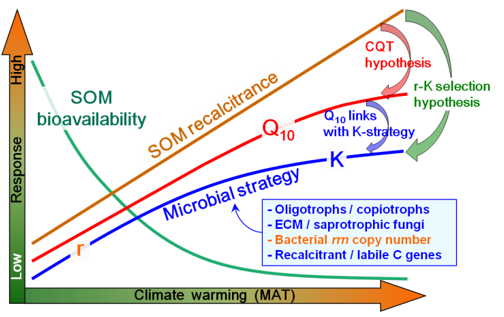
Global warming is expected to promote CO2 release from soil, and the increased atmospheric CO2 concentration will further exacerbate global warming, triggering the positive carbon-climate feedback. The magnitude of this feedback is largely dependent on the temperature sensitivity of organic matter decomposition, which is commonly indicated as Q10. Characterizing Q10 and its response to continuous warming is critical to a credible estimate of global carbon balance under future climate change.
However, given the complex interactions between Q10, SOM quality and soil microorganisms, the response pattern of Q10 to increased mean annual temperature (MAT) and the underlying mechanisms are still under debate. Since the decomposition of low quality compounds has greater temperature sensitivity than that of high quality substrates while the K-strategists prefer to utilize the relatively recalcitrant organic matter, scientists hypothesized that the Q10 would be associated with a K-selected microbial community.
To test this hypothesis, Dr. LI Hui and her colleagues from the Institute of Applied Ecology of the Chinese Academy of Sciences analyzed Q10 of soil organic matter (SOM) decomposition in 13 sites of natural temperate mixed forests along a mean annual temperature (MAT) gradient of -1.9 to 5.1 °C. The accompanying soil general properties, SOM quality and bioavailability, microbial community composition and functional genes were measured in parral.
According to the results, the Q10 values increased with MAT, in parallel with SOM recalcitrance and prevalence of K-strategy of microbial community. Here, the prevalence of microbial K-strategies was evaluated based on unique combination of the high ratios of oligotrophic to copiotrophic taxa, ectomycorrhizal (ECM) to saptotrophic fungi, functional recalcitrant to labile C degradation genes, and a low average 16S rRNA operon copy number.
These findings provide independent evidence in support of carbon quality-temperature (CQT) theory, consisting our initial hypothesis.
A 365-day incubation experiment in combination with the two-pool model suggested greater temperature sensitivity of recalcitrant SOM pool in southern warm regions compared to cold northern sites.
It is explained by the shift of microbial communities towards the K-spectrum, more adapted on hardly decomposable compounds. Thus, the researchers postulated that, under the projected climate warming, the soil C bioavailability would decrease, and the microbial community would be shifted towards a K-spectrum, and thus, the SOM decomposition would be more sensitive to increased temperature, exacerbating the positive feedback between SOM decomposition and the projected climate warming.
This study represents an important first step toward linking temperature sensitivity of SOM decomposition with the specific microbial community traits, by interpreting the phylogenetic data into ecological function.
This research has been published in Global Change Biology entitled "Temperature sensitivity of SOM decomposition is linked with a K-selected microbial community".
This work was financially supported by the National Nature Science Foundation of China (NSFC), the International Cooperation and Exchanges project between NSFC and Russian Foundation for Basic Research (RFBR), and the RUDN University program 5‐100.

Conceptual framework on the response of temperature sensitivity (Q10) of SOM decomposition to predicted climate warming, and the link of Q10 with SOM quality, bioavailability, and microbial ecological strategies. (Image by LI Hui)

86-10-68597521 (day)
86-10-68597289 (night)

86-10-68511095 (day)
86-10-68512458 (night)

cas_en@cas.cn

52 Sanlihe Rd., Xicheng District,
Beijing, China (100864)

